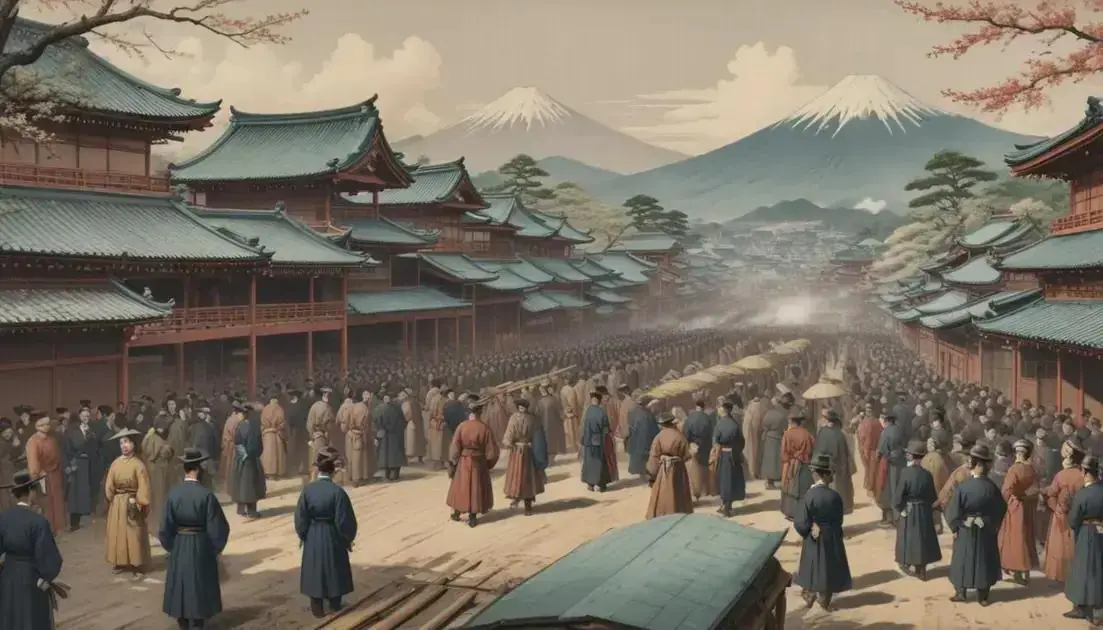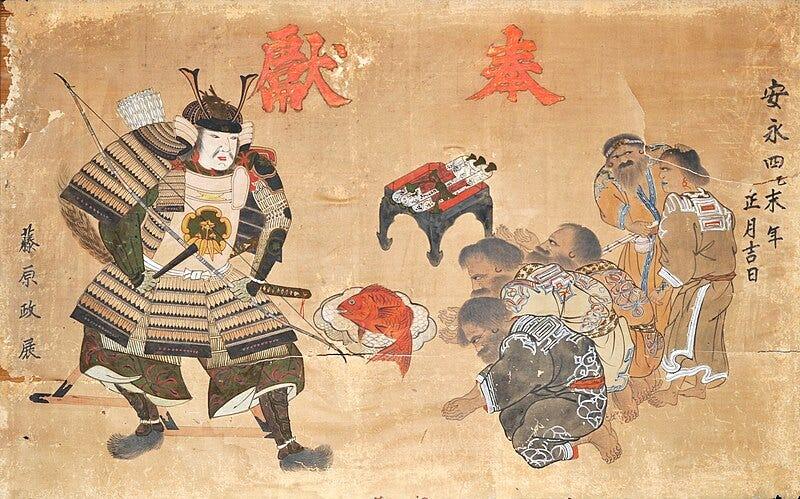
Meiji Restoration: Modernization and Transformation of Japan
The Meiji era in Japan marked a period of profound transformation, characterized by significant political, economic, and cultural changes. Political reforms established a centralized government and a parliamentary system, while economic shifts focused on industrialization, infrastructure development, and modernization of the banking system. Culturally, Japan embraced Western influences in education, art, and fashion, leading to a unique synthesis of traditional and modern elements. These changes fostered a new Japanese identity and positioned the nation as a global power.
In 1868, the Meiji Restoration marked a turning point for Japan, leading to significant changes in many aspects of society…
The end of the Tokugawa shogunate
The end of the Tokugawa shogunate came in 1868, marking a major shift in Japan’s history. For over 250 years, the Tokugawa shogunate ruled Japan, focusing on stability and isolation. This period is known as the Edo period. However, by the mid-1800s, the shogunate faced challenges from both inside and outside the country.
Internal Struggles
Many samurai and peasants were unhappy with the Tokugawa rule. They wanted more power and influence in the government. Discontent grew as the economy struggled. In the cities, people faced higher taxes and lower living standards. Unrest among the people was rising.
Influence of Foreign Powers
At the same time, foreign powers were pressing Japan to open its borders. In 1853, Commodore Matthew Perry from the United States arrived with warships. He demanded that Japan trade with America. This forced the shogunate to make difficult choices about its foreign policy.
The Movement for Change
As discontent grew, groups began calling for the end of the shogunate. These groups, known as the Sonnō Jōi (Revere the Emperor, Expel the Barbarians), pushed for a return to imperial rule. They believed the emperor should regain full powers.
Key Events Leading to Change
The situation escalated, leading to events like the Boshin War. This was a civil war between forces loyal to the emperor and those loyal to the shogunate. The war ended with the victory of imperial forces and the restoration of the emperor.
The steps that led to the end of the Tokugawa shogunate were complex. External pressures and internal conflicts combined to create a perfect storm for change. The result was a transformation that set Japan on a new path toward modernization and growth.
The role of Emperor Meiji
The role of Emperor Meiji was vital during Japan’s transition to modernization. He ascended to the throne in 1867 and became a symbol of change. His reign marked a new era for Japan, moving away from feudalism.
Symbol of Unity
Emperor Meiji was seen as a unifying figure. He inspired the people to rally around the emperor and support the country’s transformation. His leadership helped to create a strong national identity.
Political Changes
During his reign, Japan saw significant political reforms. The emperor moved to abolish the feudal structure. This led to the establishment of a centralized government. Under his direction, a constitution was adopted in 1889, introducing a parliament.
Promotion of Education
Education was a key focus for Emperor Meiji. He wanted to modernize the country through knowledge. Schools were built, and a new educational system was created. This system aimed to provide a well-educated workforce.
Economic Modernization
The emperor supported industrialization efforts. Japan adopted Western technologies and practices to grow its economy. Factories and railroads emerged, connecting different parts of the country. This growth laid the groundwork for Japan’s future as a world power.
Cultural Shifts
Under Emperor Meiji, culture also flourished. There was a mix of traditional Japanese values with Western influences. Art, literature, and fashion began to reflect this new blend. This cultural transformation was part of Japan’s overall modernization effort.
In summary, Emperor Meiji played a crucial role in Japan’s journey towards modernization. His leadership shaped the country into a powerful nation on the global stage.
Political reforms and modernization
Political reforms were key to Japan’s modernization during the Meiji period. These changes shaped the country’s government and society. The focus was on creating a strong, centralized state.
Starting Point for Reform
The political reforms began in the early 1870s. The leaders wanted to end the feudal system. They aimed to create a new government that represented the people better.
Establishment of a Constitution
In 1889, Japan adopted its first constitution. This document established a system of parliamentary government. It created a bicameral legislature known as the Diet. This gave citizens a voice in government.
Role of the Emperor
Emperor Meiji played a crucial role in these reforms. He supported the shift from a shogunate to a modern state. His presence brought legitimacy to the new government.
Legal Reforms
Military Modernization
The military was also reformed during this time. Japan built a modern army and navy. They adopted Western practices and technologies. This helped Japan become a significant power in Asia.
Impact of Reforms
The political reforms transformed Japan into a modern state. They helped create a sense of national identity and unity. People began to feel proud of their country and its progress.
Overall, these political reforms and modernization efforts set the stage for Japan’s future growth and success on the world stage.
Economic changes in Japan
Japan experienced major economic changes during the Meiji period. These changes were essential for the country’s growth and modernization. The government played a strong role in shaping the economy.
Industry Expansion
One of the first steps was to develop industries. The government built factories and encouraged private businesses. This led to the growth of textile, metal, and shipbuilding industries.
Adoption of Western Technology
Japan adopted Western technology to improve production. They learned to make better machines and tools. This helped the economy grow rapidly and compete internationally.
Infrastructure Development
Infrastructure became a focus. Railroads and telegraph lines connected cities and regions. Improved transportation helped move goods and people efficiently.
Banking System
A modern banking system was established. Banks provided loans to businesses and farmers. This access to credit allowed for more investment and growth in various sectors.
Trade and Foreign Relations
Japan opened its markets to foreign trade. New treaties with Western nations brought access to goods and technologies. This increased trade helped the economy thrive.
Impact on Society
Economic changes also affected society. Many people moved to cities for work in factories. This shift changed lifestyles and created new social structures.
In summary, economic changes in Japan during the Meiji period were vital for its modernization. These efforts set the country on a path to becoming a global power.
Cultural shifts and their impact
Cultural shifts during the Meiji era were significant and far-reaching. These changes helped shape modern Japan. The blend of traditional practices with Western influences created a unique cultural landscape.
Embrace of Western Ideas
During this time, Japan welcomed Western ideas in art, literature, and science. People were eager to learn about foreign philosophies and technologies. This led to a rich exchange of cultural practices.
Changes in Education
The education system was reformed to include Western subjects. Schools began teaching subjects like science and mathematics. This new approach aimed to prepare students for a modern society.
Art and Literature
Art and literature flourished with new styles and themes. Writers blended traditional Japanese forms with Western styles. Artists experimented with new techniques inspired by European movements.
Fashion and Social Norms
Fashion also underwent a transformation. People began to wear Western-style clothing, especially in urban areas. This change reflected a shift in social norms and attitudes.
Impact on Identity
These cultural shifts influenced Japan’s national identity. Many people began to feel a sense of pride in their unique blend of cultures. This created a modern Japanese identity that respected traditions while embracing change.
Overall, the cultural shifts during the Meiji period had a profound impact on society. They laid the groundwork for a new Japanese culture that continues to evolve today.
Conclusion
In conclusion, the cultural shifts during the Meiji era greatly shaped modern Japan. By blending traditional practices with Western influences, Japan created a unique identity. Changes in education, art, and fashion reflected this transformation and helped the nation grow.
These shifts not only influenced daily life but also established Japan as a modern power. The pride in this new cultural identity continues to resonate today. Understanding how these shifts impacted society helps us appreciate the rich history and culture of Japan.


